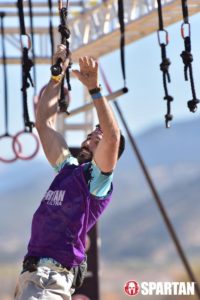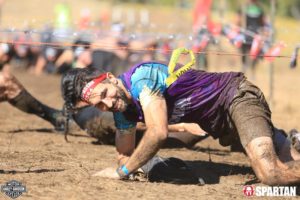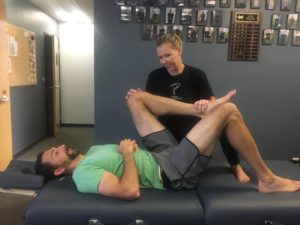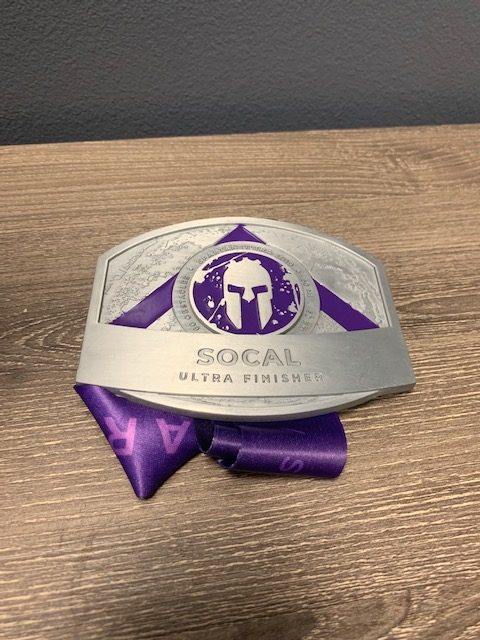Let me start off by saying this. If I can run an Ultra Beast anyone can. My entire life I have been athletic, but have really only had much success at power type sports. Sprinting, jumping, throwing, etc. These have been my strength. Running for mileage is something I never thought I would want to do or be capable of.
I wanted to make this point right off the bat, because seeing the Ultra Beast distance for many might seem intangible. But if this is something you really want to do, you absolutely can. Just make sure you are doing this for the right reason and have a solid plan in place.
At the start of this year I really had no intention of running an Ultra Beast. It wasn’t really on my radar. But I had helped quite a few clients train for it. Now to be a great coach it isn’t necessary to have done everything your clients are trying to do. The more important piece is understanding what the event requires and knowing how to train for it. Then keeping people accountable to stick with it.
But still, after helping so many people do it I started to get the itch a bit. It started with the feeling of would I want to do something like this. Or maybe a better question is could I do something like this?
And that is where it really started to dig at me. I have been doing OCR’s since 2013 with relative success over those years. In all those years, the main question I had going into a race was how fast was I going to complete this? What never came to mind was will I finish this?
I am not talking about just having a positive mindset either. Of course that is an important piece to training for something like this. But instead, we all have physical limitations at some point. I know that I cannot run a 2 hour marathon. It just isn’t going to happen.
But what is the limit? Could I run a 5 hour marathon? 4 hours? I really don’t know. I have heard stories and seen failed attempts at the Ultra Beast. I fully realize that this is a common thing. And it is not just about being in good enough shape to do it. With a race this distance, a lot of things can go wrong.
A cramp can pop up and prevent you from finishing. You can misplan your nutrition and bonk. You can have a blister stop you in your tracks. These are just a few of the very common disasters that pop up. But for some reason this compelled me and there is a good chance it has or will compell you.
What is your limit? How do we ever know? After I finished my race and posted something on Facebook about the accomplishment, a client posted a quote that was so perfect I have to repeat it here.
“Only those who will risk going too far can possibly find out how far one can go.” —T.S. Eliot.
 This isn’t to say we should go crazy and try and hurt ourselves. But in order to understand what we are capable of we have to push to levels we have never achieved before. This was my true passion that led me to this race. For the first time I wasn’t sure if I could do this. And there was only one way to find out.
This isn’t to say we should go crazy and try and hurt ourselves. But in order to understand what we are capable of we have to push to levels we have never achieved before. This was my true passion that led me to this race. For the first time I wasn’t sure if I could do this. And there was only one way to find out.
So before we go any further. If you are considering running this distance race, I think the first step you have to do is understand why you are doing it. To get the belt buckle is pretty cool, but I don’t think that is enough to really drive you for what you will need to do. Be honest here. Why is this race going to be important? It absolutely can be a life changing event for you. But the more you understand its purpose the more likely you will be able to commit to what you will have to do.
Now I would love to give a full run down of the race so you can read about exactly what we went through, but to keep this post a little shorter I am going to skip the details. If you want to full recap of how the race was and some things I experienced on the way, make sure you check out my podcast episode where I go into much more detail.
The episode may not be released by the time this post goes up, but if you keep checking at www.ocrunderground.com/episode-66 or subscribe to the show so you can get all the latest episodes when it is finally released.
For now I wanted to give you some essentials to consider if you are thinking about taking on this incredible challenge.
Prepare For Everything
Seriously Mike? Your big advice is to prepare? I think I know that already…
Sorry, yes. Clearly most, at least in concept, understand they need to prepare for a race like this. But I don’t think most really comprehend what that entails. As I mentioned earlier, there are so many things that can go wrong. You won’t be able to predict everything, but with good preparation you can limit some of these things.
The goal of this article is to get you to understand how much work training for a race like this truly involves. I have helped a number of people get their belt buckles and have done it myself. I am proud to say I had NO issues, other than being really tired, during or after the race. I’m sore everywhere still as I write this, but I know it will all pass with time. My joints are great, my muscles will be fine when the soreness passes, and I will be back at my normal training prepping for my next challenge shortly.
This is what I want for you. Not only to kick ass in this race, but to not let it destroy you in the process.
So yes we will talk about how you can prepare.
1. Training Preparation
There is simply too much to cover in one blog posts, but I will at least share some of the big rocks to take care of. Training will take time for your body to adapt. Plan for months of specific training for this race. Ideally around 6 months but potentially a year depending on where you are starting from. Here are some big things to consider.
First, get to your ideal body weight asap. Why run with excess weight? If you have some pounds of body fat you can loss get to work. Your body will thank you for this. Your joints take less pounding and you will find running and obstacles to be much easier. This should be your early training goal. Get the weight off before you start any real specific training.
Next, we want to prepare your body for the stress it is about to go under. This includes both your strength and your running program. For strength, get as strong as you can. Pretty straight forward here. But by strength I mean functional strength. Things that will carry over into the race, not just in the weight room. So if you still have a workout that is focused on a specific muscle or group of muscles, like chest day or leg day, throw out your program and start over. This type of training won’t help you.
I will be honest, I couldn’t imagine doing a single burpee during this race. I am proud to say I did not fail a single obstacle. And if I did I am not sure how I would have completed those burpees. You will feel the same way, but the goal is to be strong enough to finish every obstacle. And if that is not realistic, then get as close as you can and get use to being miserable doing those burpees.
Along with the obstacles, another guarantee in the race, is hills. Not just climbing hills but going down them. This can be a killer too if your muscles and joints are not prepared. Two key areas for helping your body prep for these are power training and eccentrics. Climbing up hills requires a lot of lower body power. So make sure you are including regular power training. Box jumps, KB Swings, and barbell cleans are all great, but remember, most of the race is done on one leg. You aren’t squat jumping up hills, you are climbing one leg at a time. So include single leg drills when possible like step jumps.
For the going down hills we can focus on eccentric muscle contractions. This is the lowering or lengthening phase of a movement. Some will refer to this as the negative. Think when you lower down in a squat.
You are already doing eccentrics every time you lift. The focus will be to enhance them. The easiest way to do this is by slowing the eccentric phase down. During a typically lift you will probably take a second to go down and a second to go up. Instead try taking 4-5 seconds to go down and 1 second to come up. This will completely change the exercise, but will start to better prepare the muscles, tendons, and joints for the stress they will face running or climbing downhill.
 2. Running Preparation
2. Running Preparation
While most get nervous for the obstacles they face, remember, running is the biggest challenge that you will face in this race. You have to start thinking of yourself as an endurance runner if you want to take this race seriously.
What I contribute my own success was to this point here. I had a good understanding of the obstacles, so my training began to focus on how to be a better runner. This includes your running form and your endurance.
Improving your running form is too big of a topic to discuss here, but you must consider it. If you can have someone film you running to see if you notice anything that can be improved. But really a trained professional will be your best bet here.
Now despite what many do, you do not need to run 30 miles in your training. There is a risk reward here. The more miles you add the more chances something can go wrong. Your first goal will be to hit 30 miles per week. Spread this out as many days as you can. As you get more mileage under your belt you will start to increase this. Your longest run will probably be around 20-22 miles in your peak phase.
Now understand that getting these longer runs takes time. This is time away from friends, family, work, etc. You must plan accordingly. Having a support system to help you out is critical. I would not have been able to do all of this training if it wasn’t for my wife. She was able to help me so I can get out and do the training I needed to do.
It also required me to schedule out my training with my work week to make sure I always got it in. Of course you will have things come up and will need to modify, but this better be a priority in your life for the next few months. Very few things should get in the way of it.
3. Preparing Your Nutrition
I mentioned the first thing is to get to our ideal weight. An important thing to understand is that nutrition for weight loss and performance is not the same. So it is good to first focus on losing the weight and then fueling for performance.
Again this is a large topic so I will do my best to summarize. The goal is to be metabolically efficient. We know our two main fuel sources for training are fats and carbs. Depending on your current training and nutrition you may be better able to utilize one of those more than the other. In most cases, people are much better able to handle carbs because that is what they eat more often.
If we look at the human body and how much fat and sugar we have stored though, we see there is way more fat. And fat is the primary fuel source for longer duration activity. But despite having more stored fat on your body than sugar, if your body prefers to use sugar it will have a hard time utilizing the fat. So even though it is sitting right there, it will not use it properly and cause you to bonk because your sugar stores are getting low.
So your goal is to become more fat efficient to help supply energy for these longer training days. There are different strategies to do this, but you may consider some low intensity workouts in a fasted state or with minimal eating before hand. Doing this often, over a prolonged time will help the body adapt to using more fat.
This doesn’t mean every workout though. Lower intensity training requires more fat, so consume less carbs to fuel it. Higher intensity training requires more carbs, so then you will want to fuel with carbs. This may be an oversimplification, but hopfully you get the idea.
Finally, as your runs get longer it is time to prepare yourself with what you can and can’t eat during your runs. This will help you get an idea how to fuel for the race. This is critical. You will want to eat something at regular intervals. It is always hard to give specific recommendations, but for every hour of training or racing you are doing you will want anywhere from 60-80g of carbs. The key is understanding what types of foods your can handle here. So test it out.
4. Preparing Your Mind and Body
Well I know this post is getting long, so I am going to combine these last two points. You are going to suffer during this race and you have to be ok with it. But the more you prepare the less you will suffer. I always tell clients training for this that 30 miles will turn any little problem into a huge problem.
 Just like you do with your car, take your body in for regular check ups. Even if you don’t have any issues at the movement. A train professional can see if anything is moving in a way it shouldn’t and help get you back on track. I personally did this and think it was one of the most important things I could have done to keep my body healthy.
Just like you do with your car, take your body in for regular check ups. Even if you don’t have any issues at the movement. A train professional can see if anything is moving in a way it shouldn’t and help get you back on track. I personally did this and think it was one of the most important things I could have done to keep my body healthy.
And if you do have a nagging injury, take care of it. Don’t search for answers online. Go see someone that can fast track your recovery. If you need help finding someone you can use this directory for medical professionals in your area: https://www.functionalmovement.com/members Just search for a SFMA professional.
The last stop is preparing your mind. You mind will control everything you do. When those small negative thoughts creep in, they will eventually take over and shut you down. The biggest advice here is to develop your own mantra.

I never thought I would say something like this. I have never been the type of personal who would see the value in a mantra, but after this I get it. I created a saying that meant something to me personally. Something that was related back to my purpose behind the race. This idea would give me strength to focus on when things were not going as planned. It would help me refocus and overcome.
You will want to do the same. Prepare your mind to be strong enough to get out of the gutter and get back on top.
Well if you can make it all the way through this post and are still reading, I think you have what it takes for an Ultra Beast. But now to put in the work. Then, just picture yourself crossing that finish line, the smile on your face, and knowing what you really have just accomplished. That is just an amazing feeling.
I hope this post gives you an idea of what you are in for. If you need more help and specific training, I am here to help. You can go through a 4 month training program will me to help you along the way to make sure you cross that finish line with your body still attached.
Over 4 month I will share with you your strength training workouts, running programs, tactical workouts, and nutrition guidelines to follow. Plus you will be able to check in with me when you need any help.


